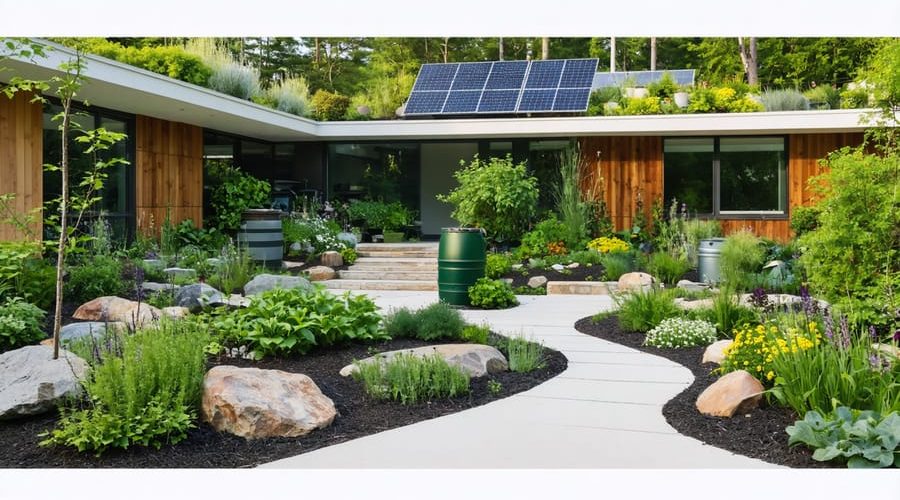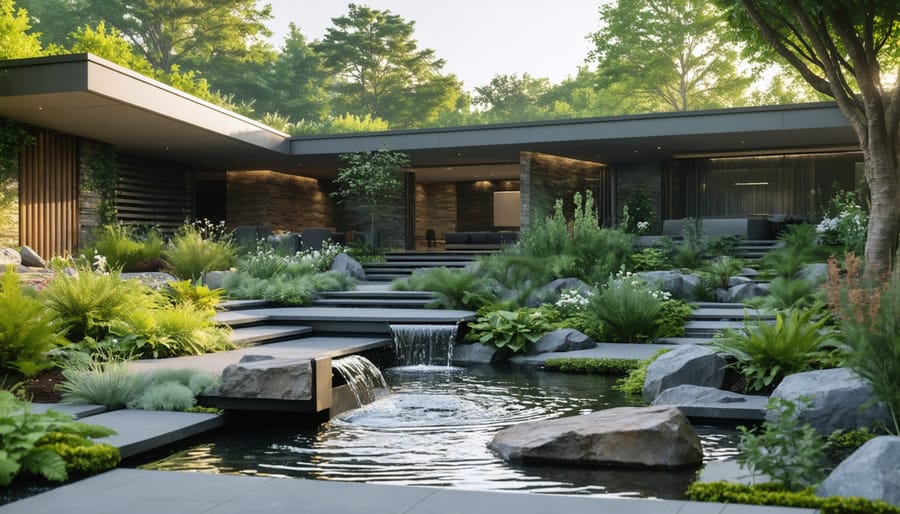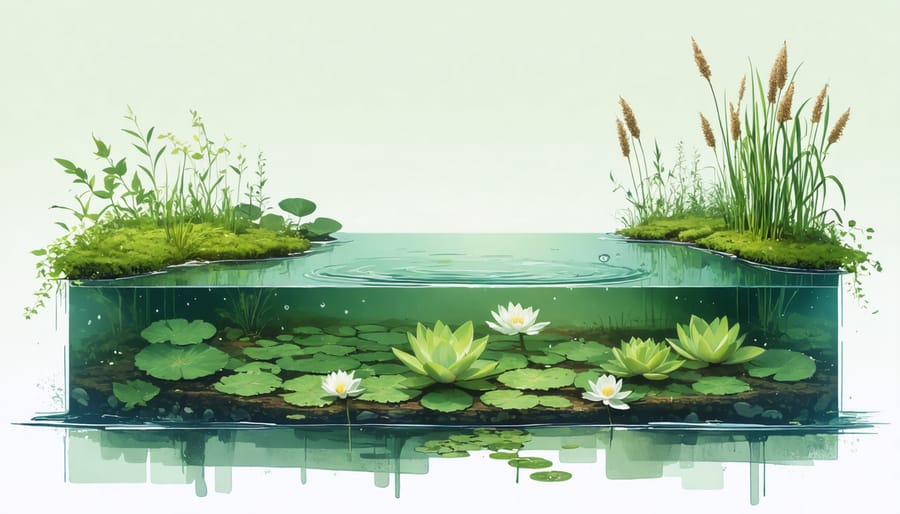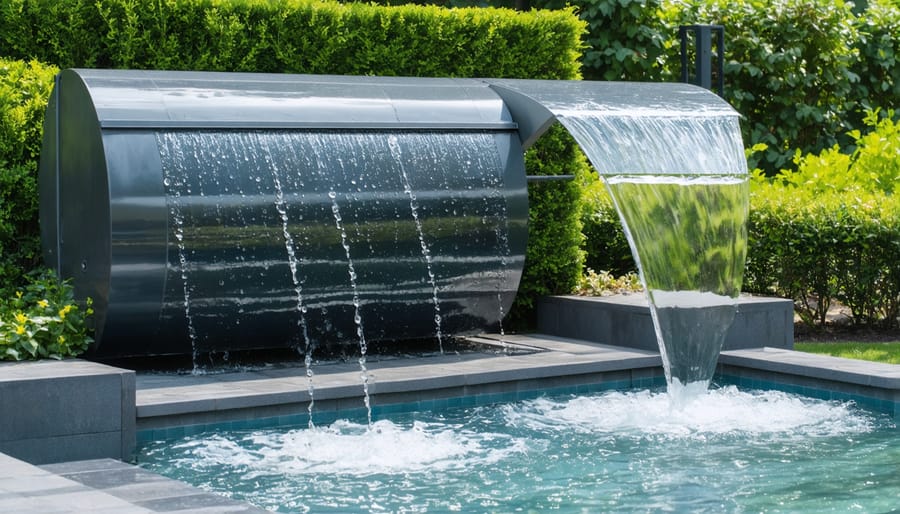
Transform Your Garden Into a Water-Saving Paradise (That Still Looks Amazing)
Transform your backyard into a thriving eco-friendly sanctuary by integrating natural pest control methods, installing efficient water management systems, and selecting native plants that support local biodiversity. Create self-sustaining garden beds using permaculture principles – layer organic mulch, establish companion planting patterns, and incorporate water-wise features that minimize resource consumption while maximizing natural habitat creation.
Start small by converting a 10×10 foot section into a chemical-free zone where beneficial insects flourish among drought-resistant perennials. Position rain barrels strategically to capture roof runoff, directing stored water to garden zones through gravity-fed irrigation systems. Install solar-powered pumps for water features, ensuring continuous circulation without increasing your carbon footprint.
This sustainable approach not only reduces maintenance costs but also creates a resilient ecosystem that adapts to changing climate conditions. By following these natural gardening practices, your outdoor space becomes both a beautiful retreat and a vital contributor to environmental conservation, proving that eco-friendly gardens can be both practical and stunning.
Smart Water Feature Design for Maximum Conservation

Choosing the Right Size and Location
When planning your eco-friendly garden, size and location play crucial roles in maximizing water efficiency. Start by analyzing your outdoor space’s natural light patterns throughout the day. Choose a spot that receives partial shade, especially during intense afternoon sun, to reduce water evaporation and protect sensitive plants.
For optimal water conservation, consider your garden’s size relative to your available resources and maintenance capabilities. A smaller, well-maintained garden often proves more sustainable than a larger one that stretches your water usage. As a general rule, start with a modest 100-square-foot area for beginners, which allows for proper plant spacing while keeping water needs manageable.
Position your garden where it can benefit from natural water flow and existing landscape features. Slight slopes can help distribute water naturally, but ensure the grade isn’t too steep to prevent soil erosion. Take advantage of natural windbreaks like fences or shrubs to reduce water loss through evaporation.
Consider grouping plants with similar water needs together, creating hydrozones that make irrigation more efficient. Place water-hungry plants in naturally moist areas or slight depressions where water naturally collects. Remember to keep your garden accessible for maintenance while maintaining enough space between plants for proper air circulation and growth.
By thoughtfully planning your garden’s size and location, you’ll create an environment that maximizes water efficiency while supporting healthy plant growth.
Water-Wise Materials Selection
Selecting the right materials for your eco-friendly garden is crucial for both sustainability and long-term success. Natural stone, reclaimed wood, and recycled materials are excellent choices that minimize environmental impact while adding character to your outdoor space. Consider using permeable pavers for pathways and patios, as they allow rainwater to seep through naturally, reducing runoff and helping replenish groundwater.
Bamboo is a fantastic sustainable material for garden structures and screens, as it grows quickly and requires minimal processing. For raised beds and borders, look for locally sourced lumber that’s been certified by the Forest Stewardship Council (FSC) or opt for composite materials made from recycled plastics and wood fibers.
When it comes to mulch and soil amendments, choose organic options like compost, leaf mold, or bark chips from local tree services. These materials not only improve soil health but also reduce waste by putting garden trimmings to good use. For garden edging and decorative elements, consider using recycled glass, broken concrete (urbanite), or salvaged metal pieces.
Water features can be constructed using recycled containers or natural stone. If you’re installing irrigation systems, choose recycled plastic piping and water-efficient components. Remember that sustainable materials often weather beautifully over time, creating a more natural and established look in your garden while reducing your environmental footprint.
Natural Filtration Systems That Work

Beneficial Plants for Natural Purification
Nature has gifted us with amazing plants that act as natural water purifiers, making them perfect additions to any eco-friendly garden. These aquatic heroes not only look beautiful but also work tirelessly to keep your water features clean and healthy.
Water lilies are among the most effective natural filters, spreading their broad leaves across the water’s surface to reduce algae growth by limiting sunlight penetration. Their stunning blooms add a pop of color while their underwater parts absorb excess nutrients that might otherwise feed unwanted algae.
Reed plants, particularly cattails and bulrushes, are excellent at removing pollutants through their extensive root systems. These tall, graceful plants create natural barriers and provide shelter for beneficial wildlife while cleaning the water.
For smaller water features, consider including water iris. These elegant plants not only produce beautiful flowers but also effectively filter out harmful substances through their root system. They’re particularly good at removing heavy metals and excess nutrients from the water.
Eichhornia crassipes, commonly known as water hyacinth, is a powerful natural filter that absorbs excess nutrients and even some toxic compounds. However, use it cautiously as it can spread rapidly in warm climates.
Don’t forget about submerged plants like hornwort and anacharis. These underwater cleaners work around the clock, oxygenating the water and competing with algae for nutrients. They’re especially useful in deeper areas of ponds and water features.
For best results, combine different types of purifying plants to create a balanced ecosystem. This natural approach reduces maintenance needs while creating a sustainable, self-cleaning water feature in your garden.
Creating a Balanced Ecosystem
Creating a self-sustaining water feature starts with careful planning and the right balance of elements. Begin by choosing a location that receives partial sunlight – about 4-6 hours daily is ideal. This balance helps prevent excessive algae growth while supporting healthy plant life.
Layer your water feature with different depths to create various habitats. Include shallow edges for marginal plants, deeper sections for aquatic plants, and the deepest area for temperature stability. A good rule of thumb is to make at least 30% of the area between 18-24 inches deep.
Select a mix of native plants to perform different ecological roles. Surface plants like water lilies provide shade and shelter, while submerged plants like hornwort help oxygenate the water. Include marginal plants around the edges to filter nutrients and create natural transitions.
To establish biological filtration, introduce beneficial bacteria through quality pond starter cultures. These microscopic helpers break down waste and maintain water quality naturally. Add small gravel or river rocks to create additional surface area for these beneficial bacteria to colonize.
Consider adding a small solar-powered pump to keep water moving gently. This prevents stagnation and mosquito breeding while providing essential oxygen. Position the pump to create a subtle current rather than a strong flow.
Finally, introduce a few small fish species like mosquito fish or native minnows once the ecosystem stabilizes. These will help control insect larvae and add life to your water feature. Remember to start with just a few fish and let the population grow naturally to maintain balance.
Regular monitoring in the first few months helps ensure everything develops properly, but once established, your eco-friendly water feature will largely maintain itself with minimal intervention.
Smart Water Management Technologies
Efficient Pumps and Circulation Systems
Choosing the right pump and circulation system for your garden water features isn’t just about keeping the water moving – it’s about doing so efficiently and sustainably. Modern eco-friendly pumps use up to 50% less energy than traditional models while delivering the same performance. Look for solar-powered options, which are perfect for smaller features and can eliminate electricity costs entirely.
Variable-speed pumps are game-changers for larger ponds and waterfalls. These smart systems automatically adjust their power output based on your garden’s needs, running at lower speeds during quiet periods and ramping up when more flow is needed. Pair these with smart water flow meters to monitor and optimize your system’s performance.
Consider magnetic drive pumps for their reliability and energy efficiency. These pumps have fewer moving parts, which means less maintenance and longer life spans. For the eco-conscious gardener, there are also new hybrid pumps that combine solar power with traditional electricity, ensuring your water features keep running even on cloudy days.
Remember to right-size your pump – an oversized pump wastes energy, while an undersized one strains to do its job. A good rule of thumb is to circulate your pond’s entire volume once every two hours for optimal efficiency and water quality.
Rainwater Harvesting Integration
Rainwater harvesting is a fantastic way to make your garden more sustainable while reducing your water bills. By collecting and storing rainwater, you can create a self-sustaining ecosystem that benefits both your plants and the environment. Start by installing rain barrels or tanks at your downspouts to capture roof runoff. These containers come in various sizes and styles, from subtle earth-toned designs to decorative options that complement your garden’s aesthetic.
Consider creating a simple DIY collection system using gutters and downspouts connected to storage tanks. To maximize efficiency, position your collection points at strategic locations where rainfall naturally concentrates. You can even monitor water consumption to track your savings and adjust your system accordingly.
Connect your harvesting system to your garden’s irrigation setup using a basic pump or gravity-fed system. This works particularly well for water features like ponds and fountains, which can be topped up naturally during rainy periods. For better filtration, install a first-flush diverter to remove initial roof debris and leaves.
Don’t forget to incorporate overflow systems for heavy rainfall and ensure proper mosquito screening on all openings. Adding a simple filter system will keep your collected water clean and suitable for garden use. During dry spells, your stored rainwater becomes an invaluable resource for maintaining your garden’s vitality without relying on municipal water supplies.

Maintenance Tips for Sustainable Success
Seasonal Care Guidelines
Spring marks the beginning of your eco-garden’s active season. Start by clearing winter debris and adding a fresh layer of organic compost to your beds. This is the perfect time to plant native seedlings and set up rainwater collection systems before the growing season kicks into high gear.
During summer, focus on water conservation through smart irrigation practices. Water deeply but less frequently to encourage deep root growth, and always water early morning or late evening to minimize evaporation. Mulch your beds with organic materials like straw or bark to retain moisture and suppress weeds naturally.
Fall is your garden’s preparation period for winter. Collect fallen leaves to create nutrient-rich leaf mold for next season. Plant cover crops in empty beds to protect and enrich the soil. This is also the ideal time to start a new compost pile with the season’s organic matter.
Winter might seem quiet, but it’s crucial for planning and maintenance. Use this time to repair tools, design spring layouts, and order organic seeds. If you have a greenhouse or cold frames, continue growing winter-hardy vegetables. Keep your compost active by adding kitchen scraps and maintaining proper moisture levels.
Year-round, remember to encourage beneficial insects by maintaining diverse plant species and avoiding chemical pesticides. Regular monitoring helps catch potential issues early, allowing for natural interventions before problems escalate.
Water Conservation Best Practices
Conserving water in your eco-friendly garden isn’t just good for the environment – it’s also great for your wallet! Start by implementing a smart irrigation system that waters your plants during early morning or late evening hours when evaporation is minimal. Installing a rain sensor ensures your system doesn’t run during or immediately after rainfall.
Mulching is your best friend when it comes to water conservation. Apply a 2-3 inch layer of organic mulch around your plants to retain moisture and reduce evaporation. Choose materials like straw, wood chips, or fallen leaves – they’re free and eco-friendly!
Consider grouping plants with similar water needs together, a practice known as hydrozoning. This prevents overwatering some plants while underwatering others. Installing efficient water flow monitoring systems helps you track usage and detect leaks early.
Collect rainwater in barrels placed under downspouts – it’s free water for your garden! For container gardens, use self-watering planters or water-retaining crystals to reduce frequency of watering. Don’t forget to check your irrigation system regularly for leaks and adjust sprinkler heads to avoid watering pathways or driveways.
Consider replacing some lawn areas with drought-resistant native plants or installing permeable pathways that allow water to seep into the ground rather than run off. These simple changes can dramatically reduce your garden’s water consumption while maintaining its beauty.
Creating an eco-friendly garden with sustainable water features is both rewarding and environmentally responsible. By implementing solar-powered pumps, incorporating native aquatic plants, and using rainwater harvesting systems, you can create a beautiful water feature that works in harmony with nature. Remember that every small step counts – from choosing local materials to maintaining proper water circulation. Starting with even a simple pond or fountain can make a significant difference in supporting local wildlife while reducing your environmental impact. Take the plunge into sustainable water gardening today, and enjoy the peaceful sounds of flowing water knowing you’re contributing to a healthier planet. Your eco-friendly water feature will not only enhance your garden’s beauty but also inspire others to make environmentally conscious choices in their outdoor spaces.
